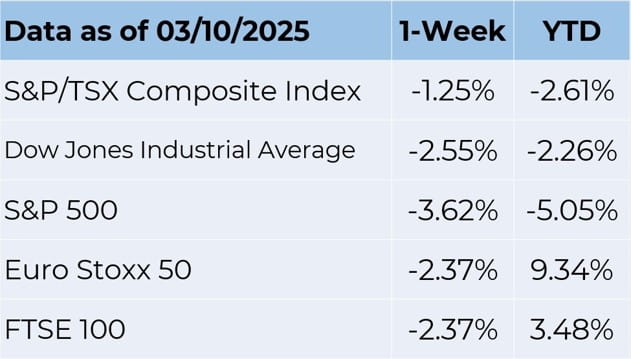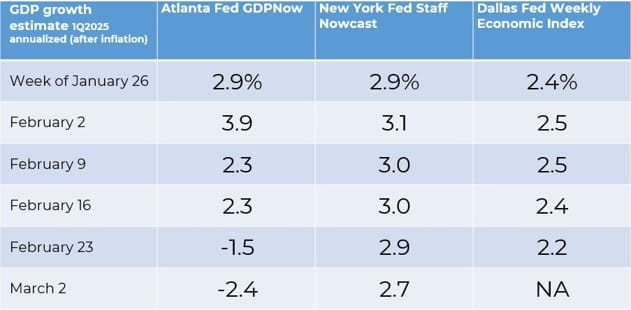Weekly Market Commentary March 18 2025
Canada vs US Trade War
Canada's central bank is ready to swing into action and protect an economy that is under immense pressure amid a trade spat with the US. Bank of Canada is on course for a seventh consecutive interest rate cut as it seeks to keep the economy afloat amid recession concerns over the US trade tariffs' impact.
A rate cut will take the country’s policy interest rate to the lowest since September 2022. Similarly, the uncertainty posed by the Trump administration could force the central bank to keep on cutting in order to stem economic damage. In the absence of the trade war, a more robust than anticipated recovery in the Canadian economy and indications of higher core inflation could have supported an easing cycle pause.
Trump has already imposed a 25% levy on most Canadian goods while threatening to impose a 50% tariff on the country’s steel and aluminium exports. Canada has also retaliated, putting tariffs on $20.8 billion worth of US goods and pledging to impose additional tariffs on C$155 billion worth of goods by April 2.
In light of the quickly shifting trade dynamics, the Bank of Canada must continue to convey that it can modify interest rates in order to mitigate the economic impact. However, Governor Tim Macklem may stress that monetary policy can only address a certain amount of the issue. In contrast to the COVID-19 epidemic, when the policy rate dropped to 0.25%, the tariff struggle will result in an inflation shock that will limit the bank's response.
Trump's tariffs and retaliation against Canada are expected to reduce the country's GDP growth by 2 to 4 percentage points, according to economists. The central bank anticipates comparable economic hardship. Macklem stated in a speech last month that a protracted trade dispute would stifle growth and reduce Canadian output by almost 3% over a two-year period. However, according to the bank's forecasts, the forces driving up prices would more than offset those driving them down, which would raise inflation.
Meanwhile, a selloff in the Canadian stock market shows no signs of slowing down. The country’s main stock index, the Toronto Stock Exchange, has already dropped to 4-month lows at 24,248. The deep pullback comes amid significant losses in the financials and consumer- related sectors hurt by the US tariffs and growing concerns about a slowdown in economic growth.
"The market is anticipating a slowdown in future growth and it's trying to price it in," said Allan Small, senior investment advisor at Allan Small Financial Group with iA Private Wealth.
Nevertheless, the Canadian main equity gauge is down less than the S&P 500, signaling that US equities are feeling the full brunt of the trade spat. The US S&P 500 has already dropped by 10% and is deep in correction mode, stung by mega-cap stock losses. Although it is still early, if the current trend continues, Canada's market will surpass its US equivalent for the third consecutive quarter.
The Markets
What do weather and investing have in common?
From 1991 to 2020, the average temperature of the United States was 54.7° Fahrenheit. Of course, that doesn’t mean the temperature in every state on every day was 54.7°F. The weather varied dramatically from place to place and month to month.
The same is true of investment averages. At the end of February, the average annual total return* for the Standard & Poor’s (S&P) 500 Index over the past 10 years was 12.98 percent. That doesn’t mean the S&P 500 returned 12.98 percent every year – it didn’t. The index’s total return varied dramatically from year to year.

The stock market doesn’t provide level returns. In some years returns are positive, and in other years returns are negative. After two years of stellar returns from U.S. stocks, the market has been experiencing a pull back.
Last week, U.S. financial markets were volatile. “A roller-coaster week for markets ended on that same note, with stocks whipsawing as traders tried to make sense of a myriad of headlines around the economy, tariffs and geopolitical developments. Just minutes after a slide that drove the S&P 500 down over 1 [percent], the gauge staged an ‘oversold bounce’ as Federal Reserve Chair Jerome Powell said the economy is fine. The Nasdaq 100 briefly breached the threshold of a correction. Bonds fell,” reported Rita Nazareth of Bloomberg.
In contrast, some European stock markets moved higher last week. “President Donald Trump’s drive to shake up the world order is creating some surprising winners. As the U.S. stock market reels from tariff fears, German stocks are surging because the government has committed to almost $1 trillion in new spending on infrastructure and defense…The sea change in policy is creating a giddy optimism in German markets not seen in decades,” reported Brian Swint of Barron’s.
The divergence in performance brings home the value of a diversified portfolio.
When markets are volatile, remain confident and resist the impulse to react to short-term performance. The assets in your portfolio were carefully chosen to help you reach your financial goals. Unless your goals and risk tolerance have changed, your asset allocation shouldn’t. The weight of evidence accumulated over previous decades supports the idea that staying the course – holding a well-allocated and diversified portfolio and rebalancing periodically – is a sound way to pursue long-term financial goals.
Last week, major U.S. stock indices finished the week lower despite a rebound on Friday. U.S. Treasury yields were mixed last week with yields for shorter maturities dropping while yields on longer maturities rose.

Source: FactSet
The Spotlight Was On The Real Federal Reserve Of Atlanta.
You may have seen a headline or two about GDPNow last week. It’s the Atlanta Federal Reserve (Fed)’s unofficial economic growth forecasting model – and it’s been delivering twists and turns worthy of a reality TV show.
GDP, or gross domestic product, is the value of all goods and services produced in the United States. “The percentage that GDP grew (or shrank) from one period to another is an important way for Americans to gauge how their economy is doing. The United States' GDP is also watched around the world as an economic barometer,” reported the Bureau of Economic Analysis.
At the end of January, the Atlanta Fed’s GDPNow model estimated the United States economy would expand by 2.9 percent in the first quarter of 2025. Since then, the estimate has moved sharply lower. Last week, GDPNow projected the U.S. economy will shrink in the first quarter, contracting by 2.4 percent.
It’s a remarkable swing that captured a lot of media attention.
How should investors weight this bit of unofficial data? Probably not too heavily because GDPNow can be volatile. “These estimates are published regularly as new economic data is released…There were 11 [releases] in February alone. Friday's [February 28’s] shock reading of -1.5% was led by a record-high $153 billion trade deficit in January, most likely as firms front- loaded imports ahead of tariffs, and Monday's decline was driven by soft manufacturing activity. There's every chance -2.8% turns into a positive reading in a few weeks,” reported Jamie McGeever of Reuters.

Other Federal Reserve Banks also have economic growth forecasts. These models also have been moving lower, but they haven’t shot into negative territory like GDPNow. The New York Nowcast dropped from an estimated 2.94 to an estimated 2.67 percent for the first quarter, and the Dallas Fed’s Weekly Economic Index moved from 2.4 percent to 2.2 percent.
The average absolute error of final GDPNow forecasts is 0.77 percentage points. The final forecast is expected in April.
Weekly Focus – Think About It
“Courage is willingness to take the risk once you know the odds. Optimistic overconfidence means you are taking the risk because you don't know the odds. It's a big difference.”
– Daniel Kahneman, Nobel Prize-winning psychologist
Best regards,
Eric Muir
B.Comm (Hons. Finance), CIM®, FCSI
Senior Portfolio Manager
Derek Lacroix
BBA, CIM®, CFP®
Associate Portfolio Manager

P.S. Please feel free to forward this commentary to family, friends or colleagues. If you would like us to add them to the list, please reply to this email with their email address and we will ask for their permission to be added.
Disclaimer:
Information in this article is from sources believed to be reliable, however, we cannot represent that it is accurate or complete. It is provided as a general source of information and should not be considered personal investment advice or solicitation to buy or sell securities. The views are those of the author, Eric Muir and Derek Lacroix and not necessarily those of Raymond James Ltd. Investors considering any investment should consult with their Investment Advisor to ensure that it is suitable for the investor’s circumstances and risk tolerance before making any investment decision. Raymond James Ltd. is a Member Canadian Investor Protection Fund.

